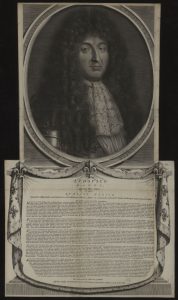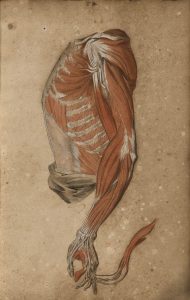~This post courtesy Solenne Coutagne, manager of digital projects at BIU Santé.
Since October 2017, the Medical Heritage Library has a new contributor, the Bibliothèque interuniversitaire de Santé (abbreviated BIU Santé).

The main reading room.
The BIU Santé (Paris) is the library of reference in the field of health in France. From its two Parisian sites (one site covering pharmacy, the other medicine and dentistry), it welcomes medical, pharmacy and odontology students, as well as health professionals (doctors, nurses, dentists, physiotherapists …) and researchers from France and the whole world.
The collection held in the site dedicated to medicine and odontology is the heir of the library of the former Faculty of Medicine in Paris (founded in the 13th century), of the Academy and College of Surgery and of the Royal Society of medicine. That library was first opened to the public in 1746. The collection was developed thanks to donations during the 18th century but also thanks to the confiscations during the French Revolution when the properties of the clergy and the nobility were confiscated and made available to increase the collections of the newly created public institutions (museums, libraries…).
The collection preserved in the site dedicated to pharmacy is inherited from the library of the Community of Apothecaries of Paris (1484-1777) which became the College of Pharmacy (1777-1796). The heritage collection was mostly extended by sales or donations at the end of the nineteenth century under the initiative of the librarian, Paul Dorveaux. Both collections increased massively as document production and the scientific press exploded during the nineteenth and twentieth centuries.
As a result, the library maintains an incredibly rich heritage collection not only in the field of medicine and pharmacy, but also in other sciences and even in other fields (history, literature, law…): The BIU Santé is renowned for holding one of the three largest medical heritage collections (with the National Library of Medicine and the Wellcome Library).
Immersed in the 36 kilometers of shelves, the heritage collection contains, among its particularities:
- All the medical dissertations supported in Parus since 1539 (online soon, from 1539 to 1793!)
- Some twenty medieval manuscripts
- A hundred incunabula
- What we called the “Commentaires de la Faculté de médecine de Paris”: 26 manuscripts volumes containing the history of the faculty written by each dean from 1395 to the French Revolution, an incredible source on the life of a European university
The essentials of occidental medicine are represented by tens of thousands of documents from the sixteenth to the eighteenth centuries. These are mostly books but also archives, prints or original drawings (including the drawings from Gérard de Lairesse (1641-1711) which were used in the Bidloo’s Anatomia humani corporis or the original Sagemolen’s drawings (c. 1620-1669) for an unedited work directed by the Dutch anatomist Van Horn (1621-1670)).
The increase of printing production in the nineteenth and twentieth centuries as well as the central position of France in medical research during this period make the BIU Santé a very important center of documentation for French and foreign researchers.
The digitization of the BIU Santé’s collection is not a new effort. In the last sixteen years, the library has digitized nearly 16, 500 documents from its collections, which represents more than 4 millions pages. All of this is already online in our digital library, Medica (http://www.biusante.parisdescartes.fr/histoire/medica) as well as in our image bank (http://www.biusante.parisdescartes.fr/histoire/images) in which, in addition to the iconographic collection of the library, all the illustrations from Medica are available.
All the material of our digital library which is in the public domain will be, step by step, uploaded into Internet Archive. We are very excited by this new project as it will enable our collection to benefit from the functionalities provided by Internet Archive and the Medical Heritage Library (full-text search …).
Offering the access to this massive collection in history of medicine in an unique place, the Medical Heritage Library will allow our collection to be highlighted, internationally better known and used.








Pingback: Breaking news : La BIU Santé rejoint la Medical Heritage Library ! -